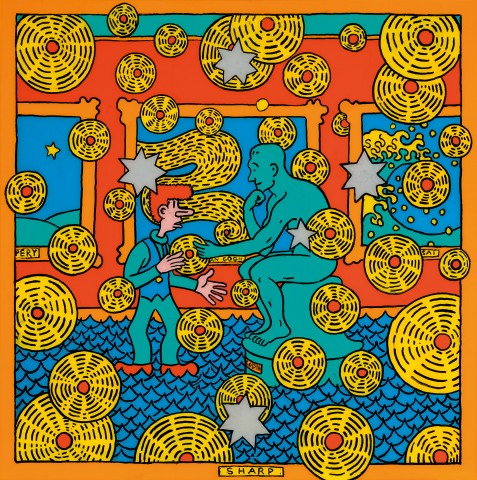ART GALAXY, 1991
MARTIN SHARP
synthetic polymer paint on plexiglass
152.0 x 152.0 cm
signed lower centre: SHARP
Julie Clarke and the late Richard Neville, New South Wales, acquired directly from the artist in 1992
Art Galaxy, 1991, colour screenprint on ivory wove paper, 81.8 x 82.0 cm (image), edition of 100, an example in the collection of the Art Gallery of New South Wales, Sydney
Art Galaxy, 1993, acrylic on paper, 82.0 x 82.0 cm, private collection, illus. (cover) The Everlasting World of Martin Sharp: Paintings from 1948 to today, Ivan Dougherty Gallery, Sydney, 2006
We are grateful to Julie Clarke-Neville for her kind assistance with the preparation of this catalogue entry.
Martin Sharp had no need to engage with the conventional art market. He sold his work to friends and admirers when he reluctantly sensed they were complete, which is how Art Galaxy, 1991 was acquired in 1992. Sometimes the same paintings would sit on easels for years; invariably there would be a radical change in direction after fresh inspiration or an intense bout of work, then it might be left to simmer again. Rather than leading to stagnation it was this luxury of time that allowed for the gestation of his most powerful and unique images.
Art Galaxy features Sharp’s own gallery of artworks that represent ideas of high culture and low culture, both local and European. Each element has been considered for years since the first version of the work emerged twenty years earlier in 1971. Here the art gallery has red walls, reminiscent of Matisse, with glimpsed fragments of three large paintings hanging on them, brass plates are attached with the names of the respective artists engraved, as in traditional art galleries. Due to the layout, the names are partly obscured, creating a mini art exam for the viewer.
The first of the paintings depicted is an illustration of a landscape from Saint-Exupery’s celebrated children’s book, The Little Prince, showing two simple hillsides with one cartoon star hanging above them. Described in the story as ‘the most beautiful and the saddest landscape in the world’, this image was a favourite of Sharp’s and he incorporated it in many works. Beside this empty landscape which evokes the innocence of childhood, Sharp hangs Hokusai’s iconic Great Wave, which spills out of the frame to cover the floor of the gallery in symmetrically scalloped blue waves. Heavy with symbolism, the great wave crashes and unfurls in a freeze-frame moment of beauty and terror. Human life is at the mercy of nature and fate, while far in the distance, Mount Fuji signifies eternity.
The final painting appropriated for Sharp’s eccentric gallery collection, is the sky detail from Van Gogh’s The Starry Night, with the intense whirl of stars here analysed and simplified into geometric shapes. Van Gogh was Sharp’s greatest inspiration, a passion which began early when he was given a book on the painter by his art teacher at Cranbrook School, Justin O’Brien. He experimented visually with many Van Gogh images, but the starry night appears even more constantly than the sunflowers in his paintings. In another layer of reality, superimposed and unrelated to the swirling starry night, or the childish star from The Little Prince, hang the stars of the Southern Cross painted in white, derived directly from the Australian flag and implying all the officialdom of the state. This indicates that the location of Sharps’ art gallery is in Australia – his birthplace, and a country about which he felt complex emotions.
On the floor of the gallery, two human figures face one another. One is ‘Boofhead’, the comic book character created by R.J. Clark and published in Australian newspapers from 1941 to 1970. Martin adored this popular comic strip and used Boofhead in many works, pondering the question: Is he really as stupid as he is represented? Or an idiot savant? Standing before Rodin’s masterpiece, The Thinker – here depicted in a vivid turquoise blue and represented, despite his gravitas, as a cartoon character himself. Representative of Australia, Boofhead looks confused as the European Thinker hands him one of Van Gogh’s stars, as if to say: “Here you are Boofhead… there’s a lot to learn!”
The Thinker, the master of ceremonies, could also represent Sharp himself, fulfilling his role - one he perceived to be attacking ignorance, raising consciousness and considering the human condition. From innocence, to the human condition, to eternity, he has curated his exhibition to make a profound statement.
To conclude, the artist has added one final brass plate at the bottom of the frame, upon which he has modestly signed his own signature in capitals – SHARP – thus making the painting itself part of the astonishing art gallery he has created.
